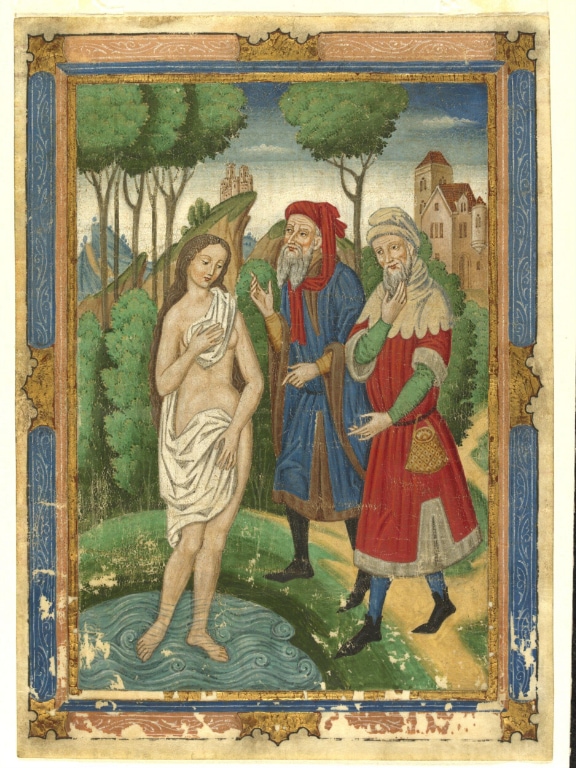Leaf from an Antiphonary with a Miniature showing Susannah and the Elders

Unknown Artist (Attributed to The Spanish Forger)
Leaf from an Antiphonary with a Miniature showing Susannah and the Elders
Paris, about 1900 (miniature); Italy, about 1400 (writing)
Pigments and gold on parchment, 205 x 145 mm
Victoria and Albert Museum (No. E.529-2008)
This cutting is a forgery painted in the 1900s on top of a manuscript from a fourteenth or fifteenth-century Italian antiphonary. The unknown artist, referred to only as the ‘Spanish Forger, would physically scrape clean one side of the parchment before painting his forgeries while keeping the other side intact (Image 1). The cutting depicts Susannah and the Elders, taken from Chapter 13 of the biblical Book of Daniel. Susannah epitomises fidelity as she refuses to give sexual favours to the two elders.
Before 1978, this and five or six related cuttings were thought to be authentic medieval leaves. It was only when pigment analysis revealed the use of modern and synthetic pigments that it became clear these cuttings were forgeries. The perpetrator was dubbed the ‘Spanish Forger’ after his work had been wrongly attributed to Maestro Jorge Ingles, an artist working in Spain in the fifteenth century. The name stuck, despite no official information on his true identity, only that he painted forgeries on genuine medieval manuscripts.
This and the related cuttings were painted on the back of text leaves of an Italian choir book. To prepare for his forgery, the perpetrator would scrape off some of the original paint to make it seem more authentic. The ready availability of manuscript cuttings to the Spanish Forger for study, thanks to the contemporary craze for collecting them, enabled him to perfect a medieval artistic style that combined biblical and courtly love themes.
The Spanish forger’s anachronistic tendencies revealed his trickery. In this case, the ‘Venus Pudica’ pose of Susannah was reminiscent of Sandro Botticelli’s Birth of Venus painted in Florence in the 1470s, whereas the background landscape and the elders’ costumes suggest a Franco-Flemish manuscript style of the early 1400s.